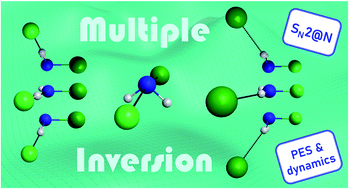Facilitated inversion complicates the stereodynamics of an SN2 reaction at nitrogen center†
Abstract
Bimolecular nucleophilic substitution (SN2) reactions at carbon center are well known to proceed with the stereospecific Walden-inversion mechanism. Reaction dynamics simulations on a newly developed high-level ab initio analytical potential energy surface for the F− + NH2Cl nitrogen-centered SN2 and proton-transfer reactions reveal a hydrogen-bond-formation-induced multiple-inversion mechanism undermining the stereospecificity of the N-centered SN2 channel. Unlike the analogous F− + CH3Cl SN2 reaction, F− + NH2Cl → Cl− + NH2F is indirect, producing a significant amount of NH2F with retention, as well as inverted NH2Cl during the timescale within the unperturbed NH2Cl molecule gets inverted with only low probability, showing the important role of facilitated inversions via an FH…NHCl−-like transition state. Proton transfer leading to HF + NHCl− is more direct and becomes the dominant product channel at higher collision energies.



 Please wait while we load your content...
Please wait while we load your content...